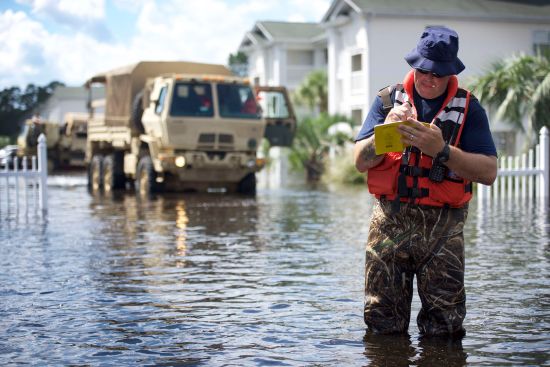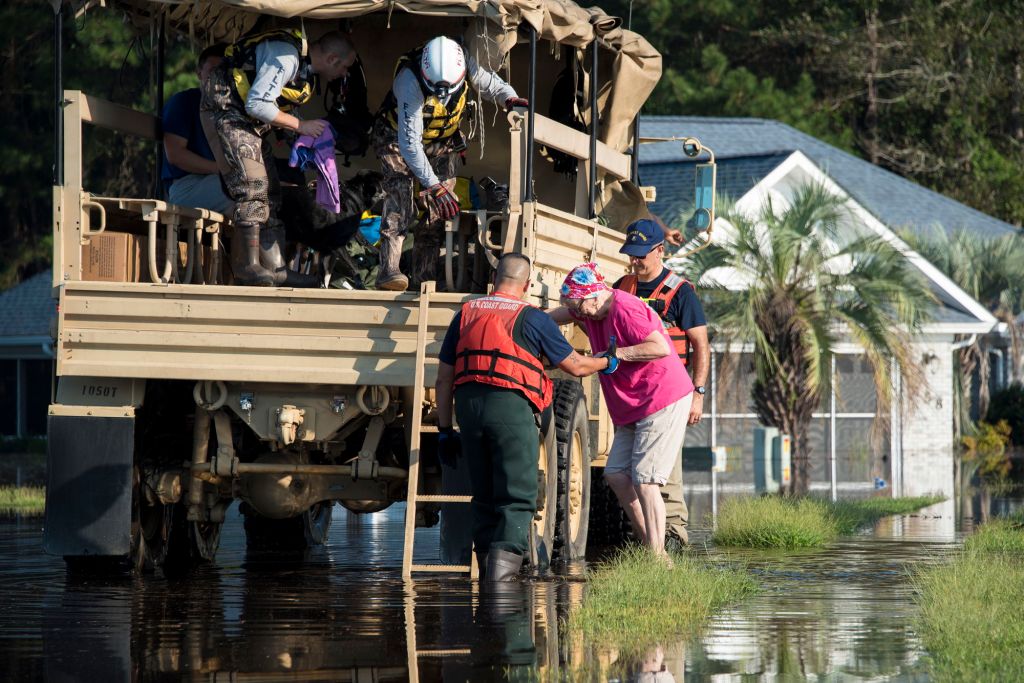Hurricane Florence’s winds had eased off by the time the storm came on shore near Wilmington, North Carolina, on September 14. But as forecast by experts, the real story was the rain, as the storm stalled out and dawdled for days in North and South Carolina before moving on and dissipating.
Now, more than a week after landfall, killer floods are hanging on in both states. Some rivers did not crest until this weekend, and others were still rising. “A week after Hurricane Florence made landfall, the trillions of gallons of water it dumped over the Carolinas are slowly moving toward the sea, leaving a path of destruction. Residential streets have turned into rivers, and freeways have morphed into waterways,” reported CNN (see: “44 dead as Florence-weary Carolinas face more flooding and rising rivers,” by Nicole Chavez and Dakin Andone). The damage continues to mount, and full recovery is sure to be a long and drawn-out struggle.
Emergency response was the immediate focus for community leaders. “Already, the emergency and recovery response is staggering in its scope, with more than 6,000 National Guard soldiers and thousands more federal disaster-response workers spread across the region,” reported The New York Times (see: “Hurricane Florence Has Gone, but Challenges for the Carolinas Have Just Begun,” by Alan Blinder and Richard Fausset). “They have six million emergency meals to hand out, four million liters of water, 700,000 blankets and 6,000 cots. Along with state and local governments, federal officials will also have to manage a daunting bureaucratic challenge as they attempt to rebuild and revive a vast area that covers hard-hit mega-farms, tourist zones and pockets of deep rural poverty.”

Petty Officer 1st Class Jon-Paul Rios
A member of the U.S. Coast Guard’s Gulf Strike Team jots down in his notebook what apartments have been evacuated after floodwaters from the Waccamaw River took over people's homes in Horry County, South Carolina, Sept. 19, 2018. U.S. Coast Guard photo by Petty Officer 1st Class Jon-Paul Rios.
Looking past the present crisis, policymakers will have to respond to the long-run impact of widespread flooding that most homeowners were unready for. “The drenching rains and massive flooding caused by Florence are expected to inflict a high financial toll on homeowners in North Carolina and other states,” reported USA Today, “as only a small percentage are covered by flood insurance that could help offset the costs of rebuilding their damaged homes.” (See: “Lack of flood insurance heaps misery on homeowners slammed by Hurricane Florence,” by Adam Shell).
“Only 10 percent to 20 percent of coastal homeowners in the hard-hit eastern part of North Carolina, for example, have coverage through the government’s National Flood Insurance Program (NFIP), and only 1 percent to 3 percent of homes in inland counties have flood policies, according to estimates from John Rollins, an actuary at consulting firm Milliman,” the paper reported. “Statewide, roughly 3 percent of the homes in North Carolina have flood coverage and 8 percent of homeowners are covered in South Carolina, Rollins said.”
Agriculture, the backbone of North Carolina’s economy, took a huge hit from Florence’s flooding, reported the Raleigh News & Observer (see: “‘The storm couldn’t have come at a worse time’ for NC’s crops,” by Colin Campbell). “Florence hit as farmers were a few weeks out from harvesting soybeans, tobacco and other fall crops,” the paper reported. “’This storm couldn’t have come at a worse time for North Carolina agriculture, N.C. Farm Bureau President Larry Wooten said during a Friday tour of Burch’s farm with Gov. Roy Cooper. Cooper said he’ll meet soon with U.S. Agriculture Secretary Sonny Perdue and ‘we’re going to see what we can do from a state and federal perspective to help our farmers.'”
Homebuilder businesses are also sure to suffer. “In light of this disaster,” the North Carolina Homebuilders Association announced, “the Board of Directors of the North Carolina Home Builders Educational & Charitable Foundation, Inc. (NCHBECF) announced the establishment of the ‘Hurricane Florence Disaster Relief Fund’ to aid members of the North Carolina Home Builders Association (NCHBA) in recovering from the devastating effects of Hurricane Florence.” (See: “Hurricane Florence Disaster Relief Fund.”)
